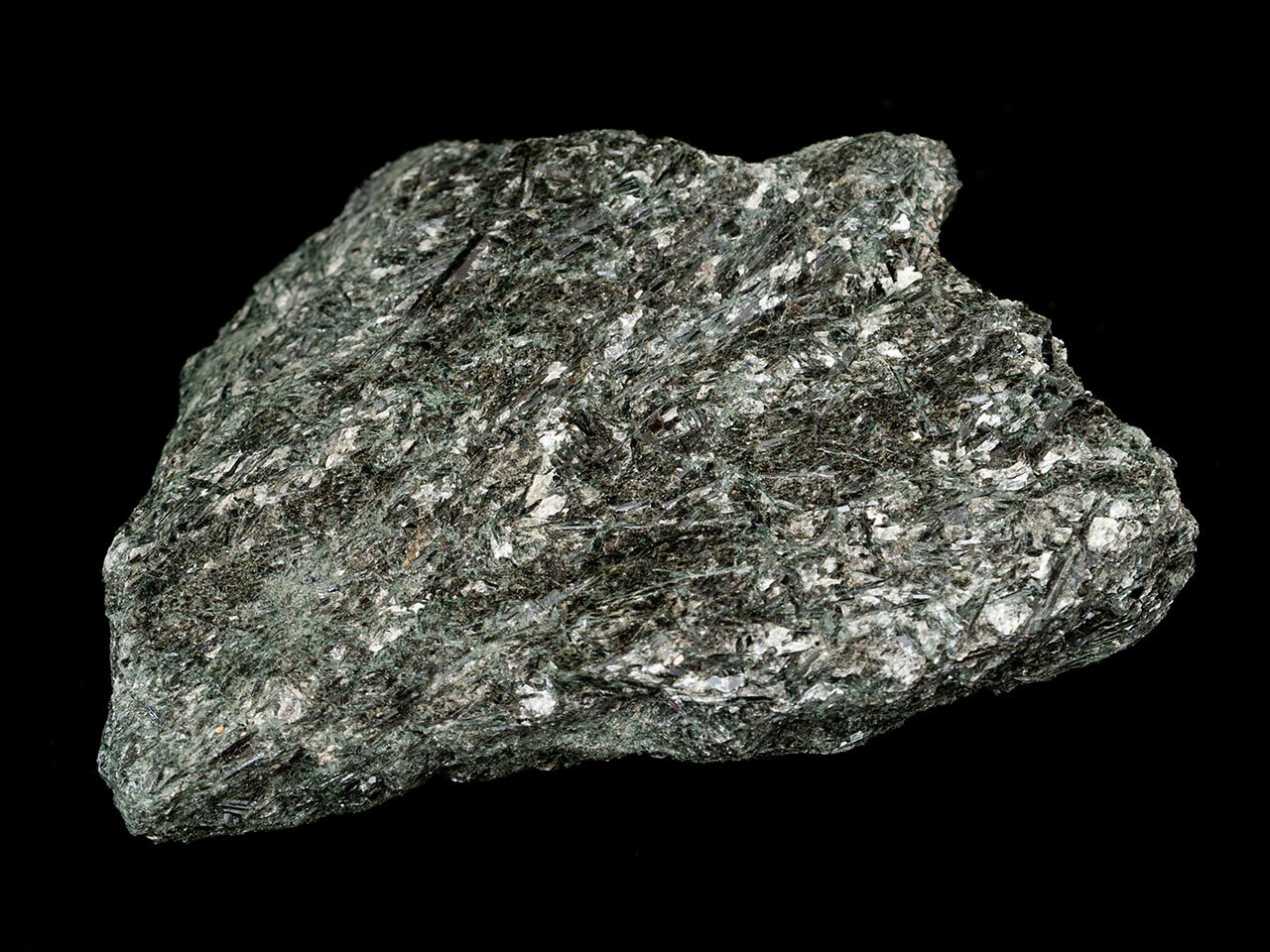
What are amphiboles, and why are they important? Amphiboles are a group of minerals known for their double-chain silicate structure. They are typically dark in color and have a hardness of 5 to 6 on the Mohs scale. Found in igneous, metamorphic, and sedimentary rocks, amphiboles play a crucial role in geological processes. They help form new continental crust in subduction zones and provide insights into magmatic differentiation. Some amphiboles, like nephrite, are even used as gemstones. However, they are also the source of asbestos, which has significant health risks. Understanding amphiboles helps us learn more about Earth's history and evolution.
Key Takeaways:
- Amphiboles are crucial minerals in Earth's geological processes, forming in various rock types over 1.9 billion years. They play a key role in magmatic and metamorphic processes, influencing the formation and evolution of rocks.
- Amphiboles have economic and cultural significance, from valuable gemstones to ancient jade carvings. They provide vital insights into Earth's history and processes, aiding in geological research and geophysical studies.
What is Amphibole?
Amphibole is a fascinating group of minerals that are essential to understanding Earth's geological processes. These minerals are found in various rock types and have unique properties that make them stand out.
-
Definition and Classification: Amphiboles belong to the amphibole supergroup and are characterized by their double-chain silicate structure. They are typically dark in color and have a hardness ranging from 5 to 6 on the Mohs scale.
-
Chemical Composition: The general chemical formula for amphiboles is ( text{Na}_xtext{Ca}_ytext{Mg}_ztext{Fe}_wtext{Al}_v(text{Si}6O{18})_u(text{OH},text{F},text{Cl})_t ). The proportions of these elements can vary, leading to different species of amphiboles.
Crystallography and Physical Properties
Understanding the crystallography and physical properties of amphiboles helps in identifying and studying them in various geological settings.
-
Crystal Symmetry: Amphiboles exhibit either monoclinic or orthorhombic crystal symmetry, with the monoclinic form being more common. This symmetry affects their optical and physical properties.
-
Age Distribution: Amphiboles have been recorded from the Paleoproterozoic to the Quaternary periods, spanning over 1.9 billion years. This wide age range highlights their significant role in Earth's history.
-
Geological Significance: Amphiboles are essential in forming igneous and metamorphic rocks. They often form from the alteration of pyroxene minerals during late stages of igneous activity or under metamorphic conditions.
Role in Magmatic and Metamorphic Processes
Amphiboles play a crucial role in magmatic and metamorphic processes, influencing the formation and evolution of rocks.
-
Role in Magmatic Evolution: In subduction zone magmas, amphiboles are key in the hydrous differentiation of calc-alkaline melts. This process contributes to the generation of new continental crust, especially in andesitic to dacitic arc volcanoes.
-
Crystallographic Forms: Amphiboles have well-developed cleavage planes that meet at 56 and 124 degrees, a characteristic feature distinguishing them from other minerals.
-
Hardness and Specific Gravity: With a hardness of 5 to 6 on the Mohs scale, amphiboles are harder than glass. Their specific gravity ranges from 3.0 to 3.4, increasing with iron content.
Appearance and Identification
The appearance and identification of amphiboles are crucial for geologists and mineral enthusiasts.
-
Color and Luster: Amphiboles are typically dark green, dark brown, or black. They often display a vitreous (glassy) to dull luster, depending on their composition and crystal structure.
-
Streak: The streak of amphiboles ranges from white to gray, useful for identifying them in the field.
Economic and Cultural Importance
Amphiboles have both economic and cultural significance, from industrial applications to ancient artifacts.
-
Economic Importance: While most common amphibole minerals have little economic value, some, like nephrite, are highly valuable as gemstones.
-
Asbestos Connection: Amphiboles are a source of asbestos, used in various industrial applications. However, health risks associated with asbestos have led to significant restrictions on its use.
-
Jade Carvings: Ancient jade carvings from Chinese palaces and Maori sites in New Zealand are famous examples of amphibole's cultural significance. These carvings are valued for their durability and beauty.
Amphiboles in Geological Research
Amphiboles are vital in geological research, providing insights into Earth's history and processes.
-
Metamorphic Sole Rocks: In Turkey's Konya area, amphiboles are found in metamorphic sole rocks of the Hatıp Ophiolitic Mélange. These rocks offer insights into the region's geological history.
-
Magmatic Processes: Amphiboles have great potential for archiving magmatic processes due to their wide stability range. Studies on amphibole chemistry and crystallography reveal complex magmatic systems.
-
Deep Crustal Evolution: Deep amphibole crystallization is crucial for magmatic differentiation and crustal evolution. Amphibole cumulate fragments from depth help study the magmatic history of various arc sections.
Amphiboles in Sedimentary Environments
Amphiboles are also found in sedimentary environments, providing information about geological provenance and processes.
-
Surface Sediments: In surface sediments, amphiboles are classified based on their charge arrangement and B-site cation types. Magnesiohornblende is the most abundant amphibole species in the South Yellow Sea (SYS).
-
Tschermakite Abundance: Tschermakite is the second most abundant amphibole species in the SYS, with an increasing trend from north to south.
-
Pargasite Presence: Pargasite is present in SYS samples, with varying content levels, indicating the diversity of amphibole species in different sedimentary environments.
-
Tremolite Occurrence: Tremolite is found in specific samples, highlighting the diversity of amphibole species in various sedimentary settings.
Amphiboles in Igneous Rocks
Amphiboles are commonly associated with igneous rocks, playing a significant role in their formation and evolution.
-
Igneous Rock Associations: Amphiboles are found in granitoids, syenitoids, and dioritoids. Their presence is often highlighted in rock names, indicating their essential role.
-
Accessory Components: In some rock names, amphiboles are listed as accessory components, indicating their secondary importance in rock formation.
-
Rock Types: Amphiboles are associated with various rock types, including granites, granodiorites, tonalites, syenites, monzonites, and diorites.
-
Alteration of Pyroxene: The alteration of pyroxene minerals to amphiboles is common in igneous rocks, occurring during late, water-wet stages of igneous activity.
Amphiboles in Volcanic Arcs
Amphiboles are essential in the formation of volcanic arcs, contributing to magmatic differentiation and crustal evolution.
-
Volcanic Arcs: Amphiboles play a crucial role in the hydrous differentiation of calc-alkaline melts, contributing to the generation of new continental crust.
-
Exposed Lower Crustal Sections: Studies on exposed lower crustal arc sections reveal the importance of deep amphibole crystallization in magmatic differentiation and crustal evolution.
-
Magmatic Plumbing Systems: Amphiboles help study complex magmatic plumbing systems, providing insights into magmatic processes and reservoir-bypassing recharges.
-
Upper Crustal Reservoirs Shift: The upper crustal reservoir is often shifted westward from the lower crustal reservoir, indicating complex magmatic plumbing systems.
Amphiboles in Magmatic Evolution
Amphiboles provide valuable information about magmatic evolution and the diversity of magma compositions.
-
Magmatic Evolution Changes: Amphiboles in dacitic MSH tephras show a wide range of textures and compositions, indicating variations in magmatic conditions.
-
Bimodal Amphibole Compositions: A progression from bimodal amphibole compositions to a more continuous distribution indicates changes in magmatic conditions.
-
Increasing Incompatible Elements: The increasing concentrations of incompatible elements suggest that magma compositions became more diverse over time.
-
Magmatic Enclave Populations: Amphiboles from magmatic enclaves record distinct populations, helping interpret the diversity of amphiboles found in dacitic tephras.
Amphiboles in Geophysical Studies
Amphiboles are used in geophysical studies to complement imaging and monitoring in volcanically active areas.
-
Geophysical Imaging: Amphiboles can be used as a complementary tool to geophysical imaging and monitoring, revealing complex magmatic processes.
-
Supplementary Data: Supplementary data on amphiboles provide additional information on their chemical compositions, textures, and geological significance.
-
Funding Support: Research on amphiboles has been supported by grants from organizations like the Swiss National Science Foundation, highlighting the importance of funding in advancing knowledge.
Geological Importance of Amphiboles
Amphiboles are crucial for understanding geological processes, particularly in the formation of igneous and metamorphic rocks.
-
Geological Importance: Amphiboles are essential for understanding geological processes, especially in forming igneous and metamorphic rocks.
-
Presence in Various Rock Types: Amphiboles are found in various rock types, indicating their significant role in shaping Earth's crust.
-
Role in Magmatic Differentiation: Amphiboles play a key role in magmatic differentiation, particularly in forming intermediate and felsic igneous rocks.
-
Hydrous Differentiation: In subduction zone magmas, amphiboles facilitate hydrous differentiation by incorporating water into the melt.
-
Crystallographic Analysis: Crystallographic analysis of amphiboles reveals their complex structure and variability, reflecting their diverse chemical compositions.
-
Microprobe Analysis: Microprobe analysis provides detailed information about amphibole chemical composition, aiding in studying crystallization conditions and magmatic evolution.
-
Metamorphic Conditions: Amphiboles crystallize under metamorphic conditions, often forming in the presence of water.
-
Magmatic Enclaves: Amphiboles found in magmatic enclaves provide valuable information about the diversity of magmatic processes.
-
Volcanic Arcs: Amphiboles are essential components in forming volcanic arcs, contributing to the generation of new continental crust.
-
Exposed Lower Crustal Sections: Studies on exposed lower crustal arc sections reveal the importance of deep amphibole crystallization in magmatic differentiation and crustal evolution.
Amphibole's Role in Earth's Story
Amphibole minerals are like the unsung heroes of geology. Their complex chemistry and unique crystal structures make them essential for understanding Earth's geological processes. Found in igneous, metamorphic, and sedimentary rocks, amphiboles help scientists decode the history of magmatic differentiation and crustal evolution. They play a key role in forming new continental crust, especially in volcanic arcs.
Despite their importance, not all amphiboles are economically valuable. However, some, like nephrite, are prized as gemstones. Amphiboles also have a darker side, being a source of asbestos, which has significant health risks.
From ancient jade carvings to modern geological studies, amphiboles have left their mark. Their presence in various rock types and geological settings highlights their crucial role in shaping our planet. Understanding amphiboles gives us a deeper appreciation of Earth's dynamic history and complex processes.
Frequently Asked Questions
Was this page helpful?
Our commitment to delivering trustworthy and engaging content is at the heart of what we do. Each fact on our site is contributed by real users like you, bringing a wealth of diverse insights and information. To ensure the highest standards of accuracy and reliability, our dedicated editors meticulously review each submission. This process guarantees that the facts we share are not only fascinating but also credible. Trust in our commitment to quality and authenticity as you explore and learn with us.


